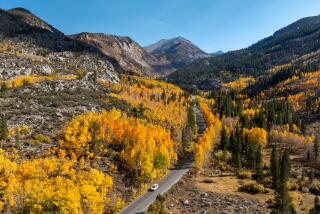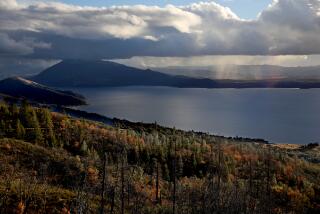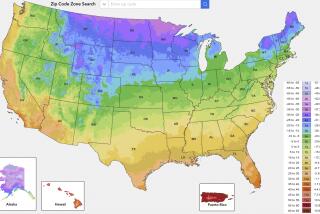Northeast Foliage: Color It Distressed
BOSTON — It is a truth universally acknowledged: With one seasonal exception, no sane person settles here for the climate. Winter chills. Summer steams. Spring is so brief--blink twice and you’ve missed it entirely.
But autumn brings redemption. Gentle days give way to cool, crisp nights. Children fight their mothers, who beg them to take a sweater, dear, please. And the colors! If the weather is mild, the leaves are explosive. Brilliant shades of ruby, topaz and garnet turn the state into a jewel box.
But this year, just as Bay Staters prepare for their glorious fall foliage floor show, the word is brown.
Decidedly, although not happily, said Dave Sheldon of the state Food and Agriculture Department, “I would judge it not to be as vivid as past years.”
What happened, said Ron Kujawski, widely acclaimed as the state’s leading leaf man, is that an especially wet late spring was followed by near-drought conditions in July and August. First the leaves were drenched, in other words; then they were scorched.
The extremes caused stress for many trees, said Kujawski, a plant ecologist who works for the University of Massachusetts Extension office in the normally leaf-laden Berkshires. As a result, the leaves on many ash, maple and birch trees went straight to brown. The trees then resorted to what botanists call premature defoliation: leaf shedding, in lay parlance.
To add insult to arboreal injury, the harsh conditions set up a perfect environment for foliar disease--leaf fungus, to be precise. “When the machinery in the leaves starts to shut down, the disease develops a little more rapidly,” Kujawski said.
Especially among maples, infections grabbed hold, causing the trees to lose leaves without reaching their full fall bloom. Kujawski said the strange set of circumstances could probably be traced to El Nino.
“We blame everything else on El Nino,” he said. “We might as well add this too.”
Farther north, meanwhile, the devastating ice storms that paralyzed much of Maine and Vermont last winter also took a toll on trees. Tim Perkins of Vermont’s Maple Research Center said that in some areas, leaves were tumbling somewhat ahead of schedule. Worse, the ice storms wiped out about 10% of Vermont’s trees.
On the other hand, Perkins pointed out, “there’s still plenty of trees. That’s 10% throughout the whole state. It’s not something you can detect with your naked eye.”
The rainy spring also confused Bay State bees, which normally spend that time pollinating the region’s apple trees. Bees, it turns out, don’t fly in the rain. Consequently, according to the state’s Cider Guild, apple production could be down this fall by as much as 40%.
Pumpkins also are suffering, Sheldon said. And again: “It’s the fungus.”
But Kujawski, a chronic optimist as well as a veteran leaf observer, said that it is too early to declare a total brownout.
Bad leaf seasons are few and far between, Kujawski cautioned. In fact, he had to reach back “at least six or seven years” before he could recall an autumn that was “a little on the dull side.”
The full glory of fall doesn’t really climax in the region until around Columbus Day, he noted. At that moment, he said, he always looks around and realizes “I don’t envy people who live in Texas or Florida or California. It’s just kind of incomparable, what we have here.”
More to Read
Sign up for Essential California
The most important California stories and recommendations in your inbox every morning.
You may occasionally receive promotional content from the Los Angeles Times.










